Tintern Abbey
Chepstow, Monmouthshire, Wales
|

Feature Location Guide |
Tintern Abbey is a near complete ruin of a
Cistercian monastery. It was the first Cistercian monastery in Wales and the
second in Britain. Today its one of our most spectacular ruins.
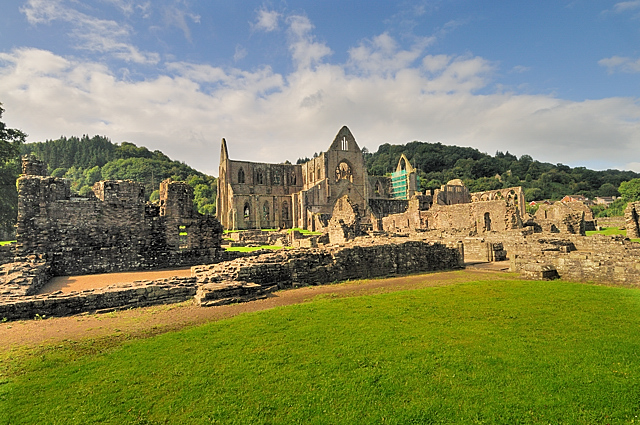

Prior to the road being put past it this was a
remote place, and this probably accounted for its survival when so many other
monasteries were used for supplies of stone and destroyed. In the mid eighteenth
century it became fashionable to visit 'wilder' parts of the country. The Wye
Valley in particular was well known for its romantic and picturesque qualities
and the ivy clad Abbey was frequented by 'romantic' tourists. After the
publication of the book 'Observations on the River Wye' by the Reverend William Gilpin in 1782, tourists visited the site in droves. The site was best
approached from the river until 1822, when a new turnpike road, now the A466,
was opened through the valley, cutting through the abbey precinct. The railway
brought still more tourists after 1876. An engraving of Tintern Abbey was among
the decorations of Fanny Price's sitting room in Jane Austen's, Mansfield Park.
William Wordsworth created the poem "Lines
Composed a Few Miles above Tintern Abbey", and more than one painting by J. M. W. Turner was based on Tintern Abbey.
and more than one painting by J. M. W. Turner was based on Tintern Abbey.
The general layout of monasteries follows a
standard pattern, but there are variations, some caused by geography, but
usually only in minor changes. Tintern Abbey is
unusual, but not unique, in that its back to front, with the cloisters to the north instead of
the south. Gloucester is another, and earlier, with a back to front arrangement.
Its history
Tintern Abbey was founded in 1131 by the
Anglo-Norman lord of Chepstow, Walter fitz Richard de Clare. He granted land to
a small group of monks from the Cistercian Abbey of l’Aumône, in the
diocese of Blois in France. The position of Tintern Abbey is typical of the
remote sites chosen for the monasteries by the Cistercians.
In time, Tintern established two daughter
houses, Kingswood in Gloucestershire (1139) and Tintern Parva, west of Wexford
in south east Ireland (1203).
The Cistercian monks (or White Monks) who lived at Tintern followed the Rule of
St. Benedict, but with more vigar, and less luxury and details in their
buildings than the Benedictines. See our article on
The development of Monasteries and
Abbeys in Britain
 . The Carta Caritatis (Charter of Love) laid out their basic principles, namely:
Obedience, Poverty, Chastity, Silence, Prayer, Work. With this austere way
of life, the Cistercians were one of the most successful orders in the 12th and
13th centuries. The lands of the Abbey were divided into agricultural units or
granges, run by lay brothers and on which local people worked and provided
services such as smithies to the Abbey. Many endowments of land on both sides of
the Wye were made to the Abbey. There is the remains of one of these granges on
the side of the entry road into the abbey, opposite the best door of the abbey
church (free entry).
. The Carta Caritatis (Charter of Love) laid out their basic principles, namely:
Obedience, Poverty, Chastity, Silence, Prayer, Work. With this austere way
of life, the Cistercians were one of the most successful orders in the 12th and
13th centuries. The lands of the Abbey were divided into agricultural units or
granges, run by lay brothers and on which local people worked and provided
services such as smithies to the Abbey. Many endowments of land on both sides of
the Wye were made to the Abbey. There is the remains of one of these granges on
the side of the entry road into the abbey, opposite the best door of the abbey
church (free entry).
It is thought that at first, the monks probably
lived and worshipped in temporary timber buildings, though by the mid-twelfth
century they had erected a stone church and cloisters. The community grew and
during the first half of the thirteenth century the abbey buildings were
expanded. The superb Gothic church that still stands, though in ruins, was begun
in 1269. It was consecrated in 1301, almost certainly in the presence of Roger
Bigod, fifth earl of Norfolk, who supported the abbey.
| The present-day remains of
Tintern are a mixture of building works covering a 400-year period
between 1136 and 1536. Very little remains of the first buildings, a few
sections of walling are incorporated into later buildings and the two
recessed cupboards for books on the east of the cloisters are from this
period. The church of that time was smaller than the present building
and was slightly to the north. During the 13th century, the Abbey was virtually rebuilt, first the
cloisters and the domestic ranges, then finally the great church between
1269 and 1301. The first mass in the rebuilt presbytery was recorded to
have taken place in 1288, and the building was consecrated in 1301,
although building work continued for several decades. Roger Bigod, 5th
Earl of Norfolk, the then lord of Chepstow, was a generous benefactor,
his monumental undertaking was the rebuilding of the church. The Abbey
put his coat of arms in the glass of its east window in gratitude to
him.
It is this great church that we see today. It has a cruciform plan with
an aisled nave, two chapels in each transept and a square ended aisled
chancel. The Gothic church represents the architectural developments of
its day in the contemporary Decorated style. The buildings are
constructed in Old Red Sandstone, of colours varying from purple to buff
and grey. The main church building is 72 metres long. |
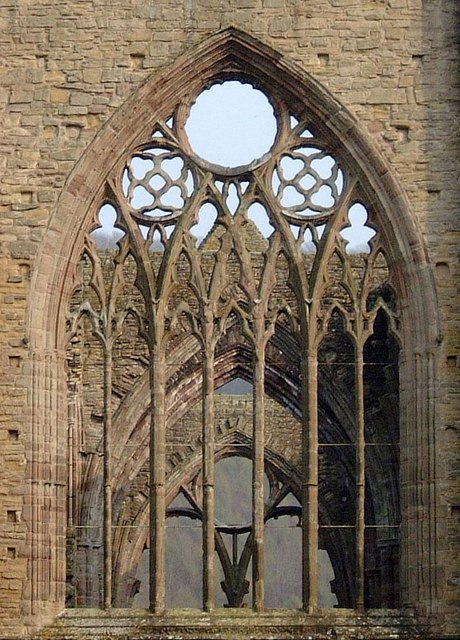
Image by
Roy Parkhouse

 |
In 1326 King Edward II visited Tintern and spent two nights there, while trying
to recover the country he was rapidly loosing, he was captured shortly after, the following year murdered at Berkeley Castle not far away in
Gloucestershire, although between these dates he had been held in several other
places. He was buried in Gloucester cathedral.
The Black Death swept the country in 1349 and
it became impossible to attract new recruits for the lay brotherhood. Changes to
the way the granges were tenanted out rather than worked by lay brothers show
the difficulty Tintern was experiencing with labour shortages. In the early
1400's Tintern was experiencing financial difficulties, due in part to the
effects of the Welsh uprising under Owain Glyndŵr against the English kings, and
Abbey properties were destroyed by the Welsh rebels.
| On September 3, 1536 Abbot
Wyche surrendered Tintern Abbey to the King's visitors, during the
suppression of the monasteries, and Henry VIII seized all its land and
wealth. The buildings and land were given to Henry Somerset, the Earl of
Worcester. Lead from the roof was sold, and the decay of the shell of
the buildings began. He began to
rent out parts of the land to local people and soon the area around the
abbey was crowded with cottages, workshops and industrial buildings.
Iron wire was produced here and further up the valley. The buildings
fell into disrepair, and the church was used for playing quoits.
It became a fashionable place to visit some
time later as we have covered above and in the nineteenth century ruined abbeys
became the focus for scholars, and architectural and archaeological
investigations were carried out. In 1901 the Abbey was bought by the crown from
the Duke of Beaufort for £15,000. It was recognised as a monument of national
importance and repair and maintenance works began to be carried out. In 1914 the
Office of Works were passed responsibility for Tintern, and major structural
repairs and partial reconstructions were undertaken — the ivy considered so
romantic by the early tourists was removed.
On our visit in August 2008,
substantial work was being done and two areas were covered with
scaffolding, I have decided therefore to show some of my images and some
by others when the scaffolding was not present. |
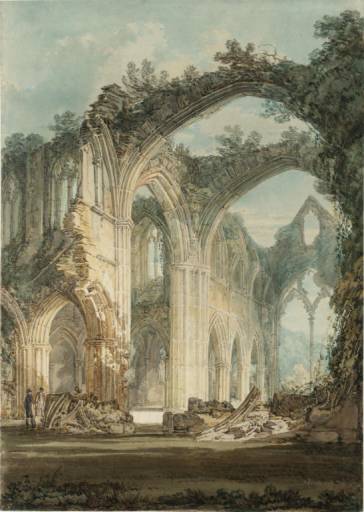
J. M. W: Turner 1794 -The Chancel and
Crossing of Tintern Abbey, Looking towards the East Window, pencil
and watercolour on paper. |
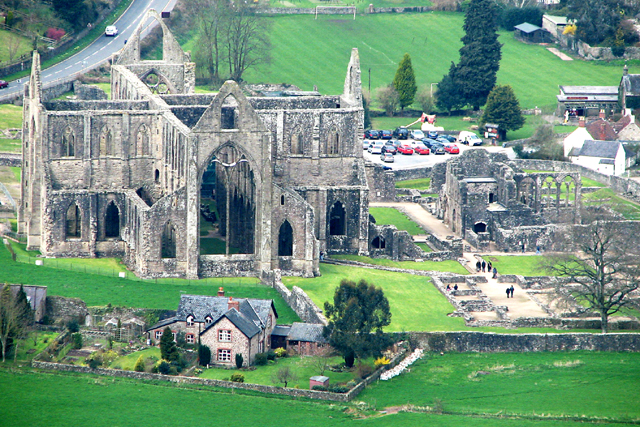
Tintern Abbey from the South East By
Roy Parkhouse 
Notice the size in relation to the farmhouse, in the
foreground |
 |
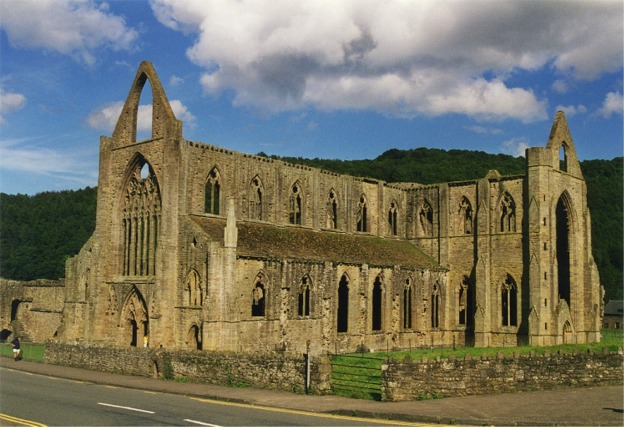
Image by
Tom Pennington


| Further information Grid
|
Location: |
Tintern Abbey, nr Chepstow, Monmouthshire |
|
Ceremonial County: |
Monmouthshire
 |
|
Grid Reference: |
SO533000 |
|
Map Link: |
StreetMap
 |
|
Aerial photo: |
Google Aerial
 |
|
Route(s):
|
|
|
Best Times to Visit: |
Most times but check opening times. Its also
floodlight at least a part of the time, so night shots a possibility from
the roadside. |
|
E-mail: |
|
|
Website: |
Cadw
 PDF Schools handout with plan
PDF Schools handout with plan
 |
|
Other useful
websites: |
Wiki
 Shef Shef
 |
|
Nearby Locations: |
|
|
Other Relevant pages: |
Abbey
Section,
 including all major Christian buildings, religious orders, normal layouts and
history.
including all major Christian buildings, religious orders, normal layouts and
history. |
|
|
.
Planning Grid
|
Location: |
Tintern Abbey, nr Chepstow, Monmouthshire |
|
Grid Reference: |
SO533000 |
|
Getting there: |
From England via M4, J21 to M48, J2 to A466
north. From Cardiff take M4, then J23 to reach M48. M48 is the
old part of the M4 that goes over the Severn Bridge (suspension bridge)
rather than over the lower Severn Second Crossing used by most traffic now. |
|
Access: |
Off side of road, well signposted, or see
maps |
|
Parking: |
Free onsite parking |
|
Facilities: |
Gift shop, exhibition, wc. |
|
Things To Do,
See and Photograph: |
Buildings, architecture, views. |
|
What to take: |
Tripod, level, wide angle lens. |
|
Nature highlights: |
A country location, with River Wye flowing next to
site visable from car park |
|
Address: |
Tintern Abbey
Tintern
Chepstow |
|
Postcode: |
NP16 6SE |
|
Telephone: |
When open 01291 689251
Central all office hours 01443 336000. |
|
Opening times: |
Mar-Jun Daily 9.30am-5pm
1st Jul-31st Aug Daily 9.30am-6pm;
1 Sep-31 Oct Daily 9.30am-5pm
Check website for up to date
information |
|
Charges: |
Adult - £3.70, Concession - £3.30, family -
£10.70
Free to Cadw members and English Heritage
members in second year of membership and on, 50% off in first year. |
|
Photo Restrictions: |
None |
|
Other Restrictions: |
None, other than don't climb on monument |
|
Special Needs Access: |
Most of the site is level, so access is not
difficult, there are perhaps parts that cannot be reached, call if you have
specific needs. |
|
Special Needs Facilities: |
Yes |
|
Children Facilities: |
Ideal place for children, no obvious dangers
but watch children in car park, the large and fast River Wye runs alongside,
although it is fenced. Once inside they cannot get to the river. |
|
Dogs Allowed: |
Guide dogs, otherwise ask. Not a good site for
dogs. |
|

|
Please let us know any other information that we
can add to the Further information and Planning Grids or page and any errors that you discover. Before making a long trip to any location it is always
wise to double check the current information, websites like magazines may be
correct at the time the information is written, but things change and it is of
course impossible to double check all entries on a regular basis. If you have
any good photographs that you feel would improve the illustration of this page
then please let us have copies. In referring to this page it is helpful if you
quote the Page Ref at the bottom of the Planning Grid above. To print the
planning grid select it then right click and print the selected area.
Please submit information on locations you discover so
that this system continues to grow.
|